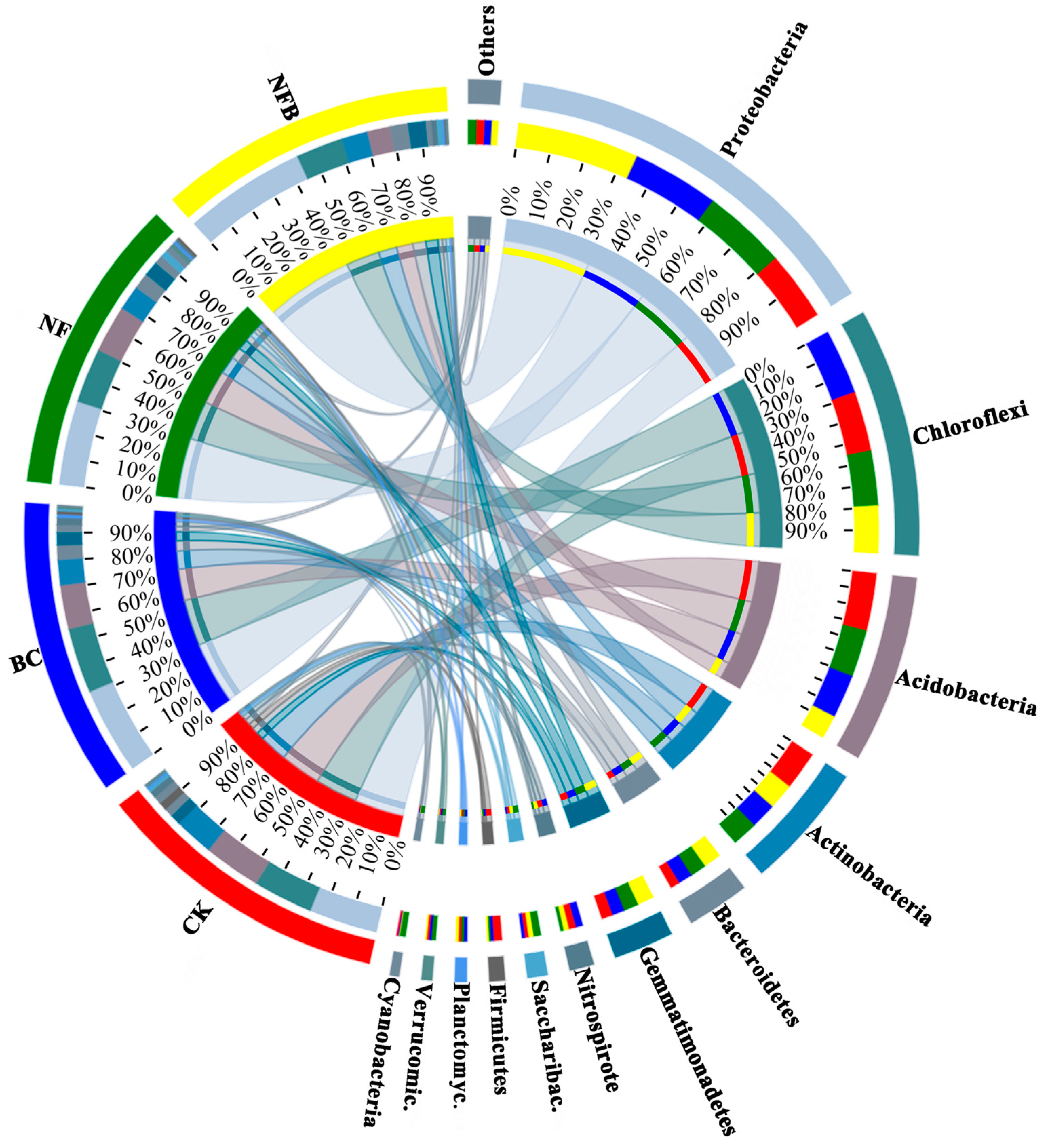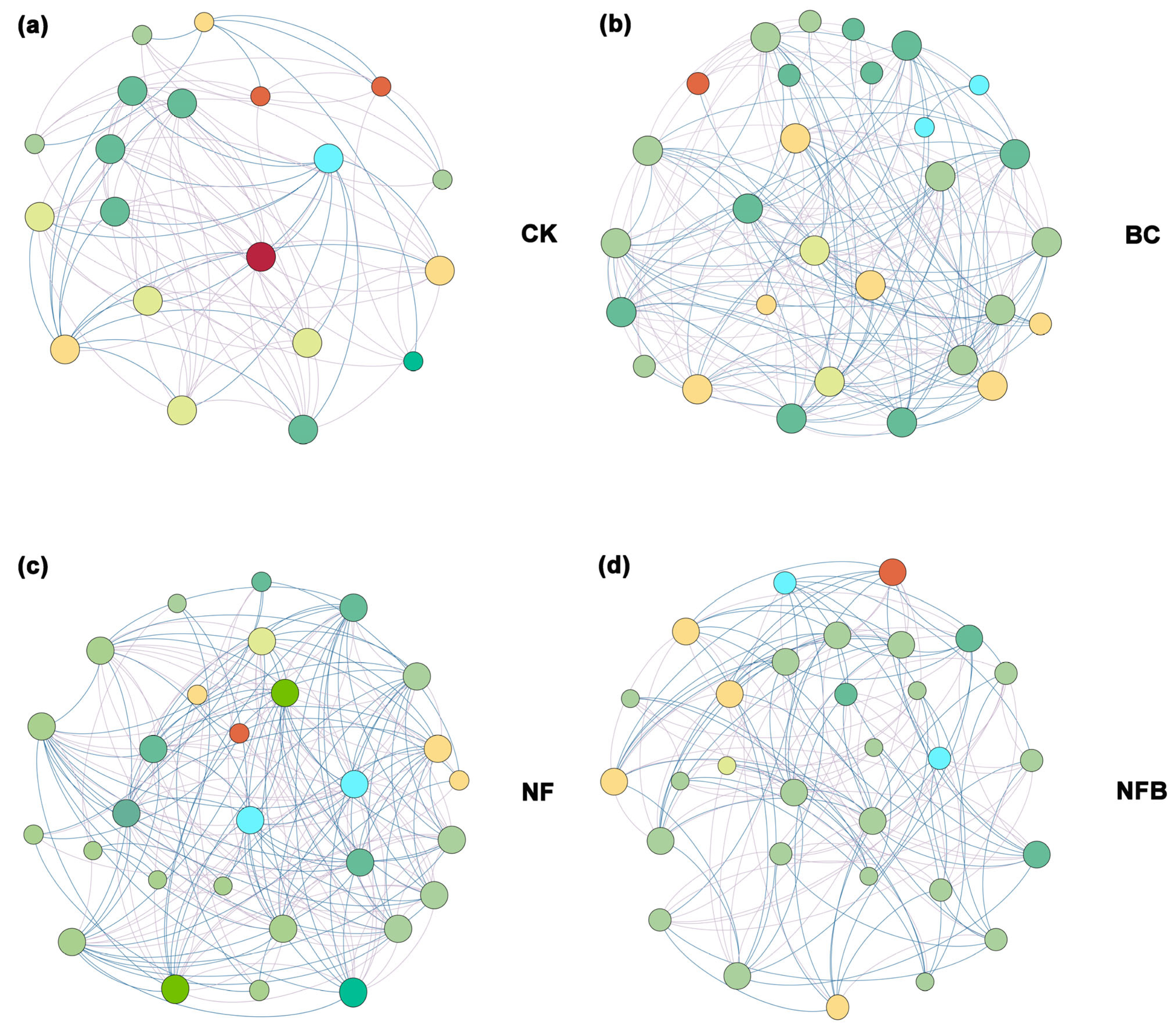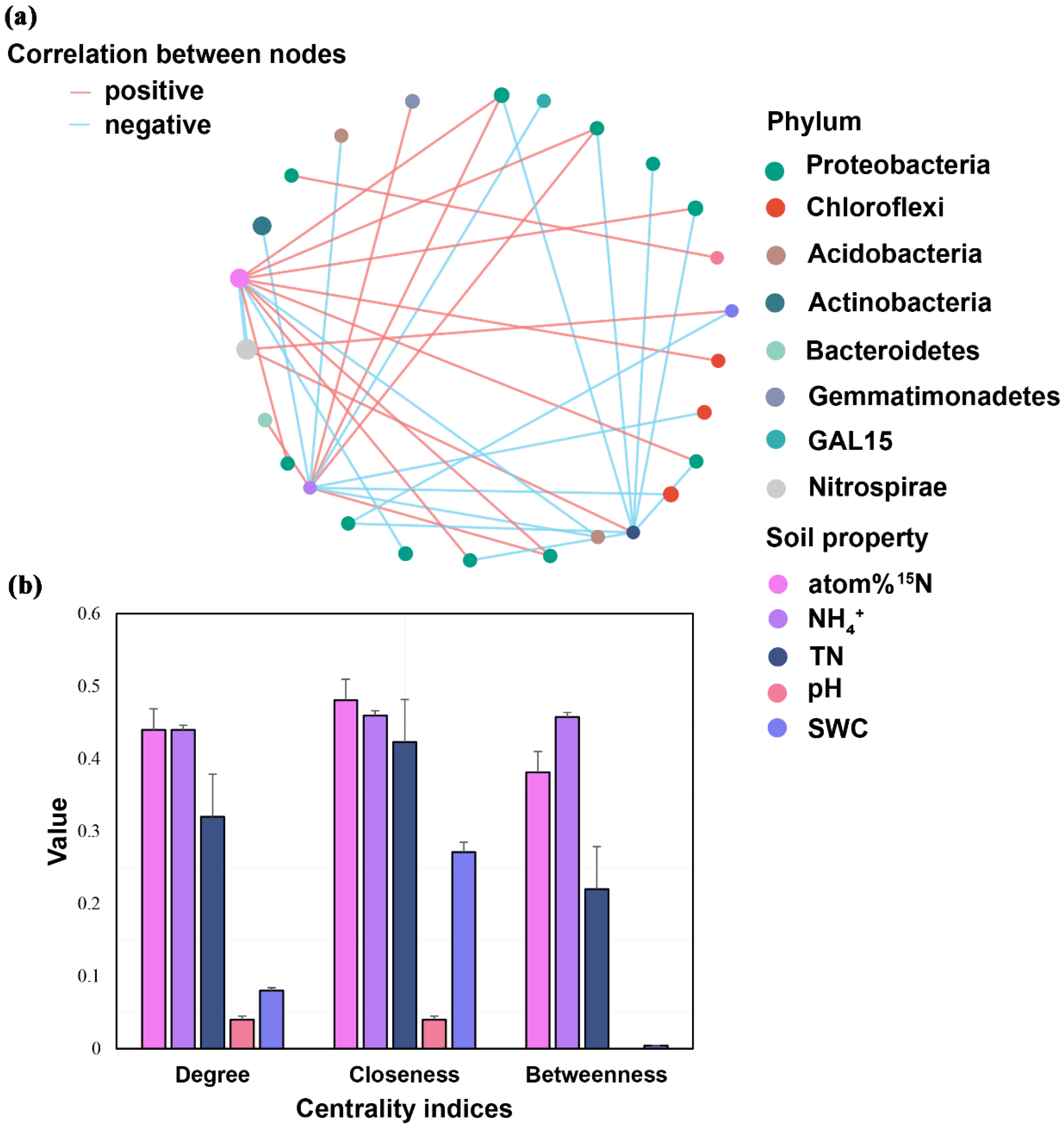Interactive Effects of Biochar and Nitrogen Fertilizer on Plant Performance Mediated by Soil Microbial Community in a Eucalypt Plantation
Abstract
:1. Introduction
2. Materials and Methods
2.1. Study Site
2.2. Experimental Design
2.3. Field Sampling and Measurements
2.3.1. Plant and Soil Sampling
2.3.2. Plant and Soil Sample Measurements
2.4. Statistical Analysis
3. Results
3.1. Soil Nutrients
3.2. Soil Microbial Community
3.3. Plant Performance
3.4. Bacterial Co-Occurrence Network and Putative Keystone Taxa
3.5. Multivariate Relationships between Inner Plant and Soil
4. Discussion
4.1. Plant and Soil Properties
4.2. Soil Microbial Diversity Indices and Composition
4.3. Influence of Biochar and Fertilizer on Relationships between Soil Putative Keystone Taxa and Soil Property
4.4. Pathways of How Microbes Influence Plant Performance
5. Conclusions
Supplementary Materials
Author Contributions
Funding
Data Availability Statement
Acknowledgments
Conflicts of Interest
References
- Nielsen, P.L.; Andresen, L.C.; Michelsen, A.; Schmidt, I.K.; Kongstad, J. Seasonal Variations and Effects of Nutrient Applications on N and P and Microbial Biomass under Two Temperate Heathland Plants. Appl. Soil Ecol. 2009, 42, 279–287. [Google Scholar] [CrossRef]
- Liu, G.; Bai, Z.; Shah, F.; Cui, G.; Xiao, Z.; Gong, H.; Li, D.; Lin, Y.; Li, B.; Ji, G.; et al. Compositional and Structural Changes in Soil Microbial Communities in Response to Straw Mulching and Plant Revegetation in an Abandoned Artificial Pasture in Northeast China. Glob. Ecol. Conserv. 2021, 31, e01871. [Google Scholar] [CrossRef]
- Feng, M.; Adams, J.M.; Fan, K.; Shi, Y.; Sun, R.; Wang, D.; Guo, X.; Chu, H. Long-Term Fertilization Influences Community Assembly Processes of Soil Diazotrophs. Soil Biol. Biochem. 2018, 126, 151–158. [Google Scholar] [CrossRef]
- Zhang, X.; Dong, W.; Dai, X.; Schaeffer, S.; Yang, F.; Radosevich, M.; Xu, L.; Liu, X.; Sun, X. Responses of Absolute and Specific Soil Enzyme Activities to Long Term Additions of Organic and Mineral Fertilizer. Sci. Total Environ. 2015, 536, 59–67. [Google Scholar] [CrossRef]
- Peter, M. Ectomycorrhizal Fungi—Fairy Rings and the Wood-Wide Web. New Phytol. 2006, 171, 685–687. [Google Scholar] [CrossRef]
- Dodor, D.E.; Tabatabai, M.A. Arylamidase Activity as an Index of Nitrogen Mineralization in Soils. Commun. Soil Sci. Plant Anal. 2007, 38, 2197–2207. [Google Scholar] [CrossRef]
- Kolton, M.; Graber, E.R.; Tsehansky, L.; Elad, Y.; Cytryn, E. Biochar-Stimulated Plant Performance Is Strongly Linked to Microbial Diversity and Metabolic Potential in the Rhizosphere. New Phytol. 2017, 213, 1393–1404. [Google Scholar] [CrossRef]
- Oguntunde, P.G.; Fosu, M.; Ajayi, A.E.; Van De Giesen, N. De Effects of Charcoal Production on Maize Yield, Chemical Properties and Texture of Soil. Biol. Fertil. Soils 2004, 39, 295–299. [Google Scholar] [CrossRef]
- Chan, K.Y.; Van Zwieten, L.; Meszaros, I.; Downie, A.; Joseph, S. Agronomic Values of Greenwaste Biochar as a Soil Amendment. Aust. J. Soil Res. 2007, 45, 629–634. [Google Scholar] [CrossRef]
- Glaser, B.; Haumaier, L.; Guggenberger, G.; Zech, W. The “Terra Preta” Phenomenon: A Model for Sustainable Agriculture in the Humid Tropics. Naturwissenschaften 2001, 88, 37–41. [Google Scholar] [CrossRef]
- Pereira, E.I.P.; Suddick, E.C.; Mansour, I.; Mukome, F.N.D.; Parikh, S.J.; Scow, K.; Six, J. Biochar Alters Nitrogen Transformations but Has Minimal Effects on Nitrous Oxide Emissions in an Organically Managed Lettuce Mesocosm. Biol. Fertil. Soils 2015, 51, 573–582. [Google Scholar] [CrossRef]
- Chan, K.Y.; Van Zwieten, L.; Meszaros, I.; Downie, A.; Joseph, S. Using Poultry Litter Biochars as Soil Amendments. Aust. J. Soil Res. 2008, 46, 437–444. [Google Scholar] [CrossRef]
- Mia, S.; Dijkstra, F.A.; Singh, B. Enhanced Biological Nitrogen Fixation and Competitive Advantage of Legumes in Mixed Pastures Diminish with Biochar Aging. Plant Soil 2018, 424, 639–651. [Google Scholar] [CrossRef]
- Lehmann, J.; Rillig, M.C.; Thies, J.; Masiello, C.A.; Hockaday, W.C.; Crowley, D. Biochar Effects on Soil Biota—A Review. Soil Biol. Biochem. 2011, 43, 1812–1836. [Google Scholar] [CrossRef]
- Seneviratne, M.; Weerasundara, L.; Ok, Y.S.; Rinklebe, J.J.; Vithanage, M. Phytotoxicity Attenuation in Vigna Radiata under Heavy Metal Stress at the Presence of Biochar and N Fixing Bacteria. J. Environ. Manag. 2016, 186, 293–300. [Google Scholar] [CrossRef] [PubMed]
- Ennis, C.J.; Evans, A.G.; Islam, M.; Ralebitso-Senior, T.K.; Senior, E. Biochar: Carbon Sequestration, Land Remediation, and Impacts on Soil Microbiology. Crit. Rev. Environ. Sci. Technol. 2012, 42, 2311–2364. [Google Scholar] [CrossRef]
- Rutigliano, F.A.; Romano, M.; Marzaioli, R.; Baglivo, I.; Baronti, S.; Miglietta, F.; Castaldi, S. Effect of Biochar Addition on Soil Microbial Community in a Wheat Crop. Eur. J. Soil Biol. 2014, 60, 9–15. [Google Scholar] [CrossRef]
- Halmi, M.F.A.; Simarani, K. Effect of Two Contrasting Biochars on Soil Microbiota in the Humid Tropics of Peninsular Malaysia. Geoderma 2021, 395, 115088. [Google Scholar] [CrossRef]
- Hu, L.; Cao, L.; Zhang, R. Bacterial and Fungal Taxon Changes in Soil Microbial Community Composition Induced by Short-Term Biochar Amendment in Red Oxidized Loam Soil. World J. Microbiol. Biotechnol. 2014, 30, 1085–1092. [Google Scholar] [CrossRef]
- Warnock, D.D.; Lehmann, J.; Kuyper, T.W.; Rillig, M.C. Mycorrhizal Responses to Biochar in Soil—Concepts and Mechanisms. Plant Soil 2007, 300, 9–20. [Google Scholar] [CrossRef]
- Gai, X.; Liu, H.; Zhai, L.; Wang, H. Effects of Corn-Stalk Biochar on Inorganic Nitrogen Leaching from Soil. J. Agro-Environ. Sci. 2015, 34, 310–318. [Google Scholar] [CrossRef]
- Yue, F.X.; Li, J.W.; Wang, Y.F.; Shi, Z.Y.; Liu, L. Mechanism of the Improvement Effect by Biochar and AM Fungi on the Availability of Soil Nutrients in Coal Mining Area. J. Plant Nutr. Fertil. 2019, 25, 1325–1334. [Google Scholar] [CrossRef]
- Khodadad, C.L.M.M.; Zimmerman, A.R.; Green, S.J.; Uthandi, S.; Foster, J.S. Taxa-Specific Changes in Soil Microbial Community Composition Induced by Pyrogenic Carbon Amendments. Soil Biol. Biochem. 2011, 43, 385–392. [Google Scholar] [CrossRef]
- Zhou, X.; Chen, Z.; Li, Z.; Wu, H. Impacts of Aeration and Biochar Addition on Extracellular Polymeric Substances and Microbial Communities in Constructed Wetlands for Low C/N Wastewater Treatment: Implications for Clogging. Chem. Eng. J. 2020, 396, 125349. [Google Scholar] [CrossRef]
- Zhao, B.C.; Xu, J.D.; Chen, B.Y.; Cao, X.F.; Yuan, T.Q.; Wang, S.F.; Charlton, A.; Sun, R.C. Selective Precipitation and Characterization of Lignin–Carbohydrate Complexes (LCCs) from Eucalyptus. Planta 2018, 247, 1077–1087. [Google Scholar] [CrossRef] [PubMed]
- Li, C.; Shi, L.L.; Ostermann, A.; Xu, J.; Li, Y.; Mortimer, P.E. Indigenous Trees Restore Soil Microbial Biomass at Faster Rates than Exotic Species. Plant Soil 2015, 396, 151–161. [Google Scholar] [CrossRef]
- Castro-Díez, P.; Alonso, Á.; Saldaña-López, A.; Granda, E. Effects of Widespread Non-Native Trees on Regulating Ecosystem Services. Sci. Total Environ. 2021, 778, 146141. [Google Scholar] [CrossRef]
- Harmand, J.M.; Njiti, C.F.; Bernhard-Reversat, F.; Puig, H. Aboveground and Belowground Biomass, Productivity and Nutrient Accumulation in Tree Improved Fallows in the Dry Tropics of Cameroon. For. Ecol. Manag. 2004, 188, 249–265. [Google Scholar] [CrossRef]
- Lynch, H.B.; Epps, K.Y.; Fukami, T.; Vitousek, P.M. Introduced Canopy Tree Species Effect on the Soil Microbial Community in a Montane Tropical Forest. Pac. Sci. 2012, 66, 141–150. [Google Scholar] [CrossRef]
- Song, Q.; Qin, F.; He, H.; Wang, H.; Yu, S. Allelopathic Potential of Rain Leachates from Eucalyptus urophylla on Four Tree Species. Agrofor. Syst. 2019, 93, 1307–1318. [Google Scholar] [CrossRef]
- Yao, X.; Li, Y.; Liao, L.; Sun, G.; Wang, H.; Ye, S. Enhancement of Nutrient Absorption and Interspecific Nitrogen Transfer in a Eucalyptus urophylla × eucalyptus grandis and Dalbergia odorifera Mixed Plantation. For. Ecol. Manag. 2019, 449, 117465. [Google Scholar] [CrossRef]
- Ren, H.; Huang, B.; Fernández-garcía, V.; Miesel, J.; Yan, L. Biochar and Rhizobacteria Amendments Improve Several Soil Properties. Microorganisms 2020, 8, 502. [Google Scholar] [CrossRef] [PubMed]
- Rosseel, Y. Lavaan: An R package for structural equation modeling and more. J. Stat. Software 2012, 48, 1–36. [Google Scholar] [CrossRef]
- Agegnehu, G.; Bass, A.M.; Nelson, P.N.; Muirhead, B.; Wright, G.; Bird, M.I. Biochar and Biochar-Compost as Soil Amendments: Effects on Peanut Yield, Soil Properties and Greenhouse Gas Emissions in Tropical North Queensland, Australia. Agric. Ecosyst. Environ. 2015, 213, 72–85. [Google Scholar] [CrossRef]
- Masulili, A.; Utomo, W.H.; MS, S. Rice Husk Biochar for Rice Based Cropping System in Acid Soil 1. The Characteristics of Rice Husk Biochar and Its Influence on the Properties of Acid Sulfate Soils and Rice Growth in West Kalimantan, Indonesia. J. Agric. Sci. 2014, 2, 39–47. [Google Scholar] [CrossRef]
- Jeffery, S.; Verheijen, F.G.A.; van der Velde, M.; Bastos, A.C. A Quantitative Review of the Effects of Biochar Application to Soils on Crop Productivity Using Meta-Analysis. Agric. Ecosyst. Environ. 2011, 144, 175–187. [Google Scholar] [CrossRef]
- Agegnehu, G.; Bass, A.M.; Nelson, P.N.; Bird, M.I. Benefits of Biochar, Compost and Biochar-Compost for Soil Quality, Maize Yield and Greenhouse Gas Emissions in a Tropical Agricultural Soil. Sci. Total Environ. 2016, 543, 295–306. [Google Scholar] [CrossRef]
- Crombie, K.; Mašek, O.; Cross, A.; Sohi, S. Biochar—Synergies and Trade-Offs between Soil Enhancing Properties and C Sequestration Potential. GCB Bioenergy 2015, 7, 1161–1175. [Google Scholar] [CrossRef]
- Hossain, M.Z.; Bahar, M.M.; Sarkar, B.; Donne, S.W.; Ok, Y.S.; Palansooriya, K.N.; Kirkham, M.B.; Chowdhury, S.; Bolan, N. Biochar and Its Importance on Nutrient Dynamics in Soil and Plant; Springer: Singapore, 2020; Volume 2, ISBN 0123456789. [Google Scholar]
- Ren, H.; Warnock, D.D.; Tiemann, L.K.; Quigley, K.; Miesel, J.R. Evaluating Foliar Characteristics as Early Indicators of Plant Response to Biochar Amendments. For. Ecol. Manag. 2021, 489, 119047. [Google Scholar] [CrossRef]
- Chu, G.X.; Shen, Q.R.; Cao, J.L. Nitrogen Fixation and N Transfer from Peanut to Rice Cultivated in Aerobic Soil in an Intercropping System and Its Effect on Soil N Fertility. Plant Soil 2004, 263, 17–27. [Google Scholar] [CrossRef]
- Heidari, A.; Watkins, D.; Mayer, A.; Propato, T.; Verón, S.; de Abelleyra, D. Spatially Variable Hydrologic Impact and Biomass Production Tradeoffs Associated with Eucalyptus (E. grandis) Cultivation for Biofuel Production in Entre Rios, Argentina. GCB Bioenergy 2021, 13, 823–837. [Google Scholar] [CrossRef]
- Wang, W.; Wu, Z.; He, Y.; Huang, Y.; Li, X.; Ye, B.C. Plant Growth Promotion and Alleviation of Salinity Stress in Capsicum annuum L. by Bacillus Isolated from Saline Soil in Xinjiang. Ecotoxicol. Environ. Saf. 2018, 164, 520–529. [Google Scholar] [CrossRef] [PubMed]
- Butphu, S.; Rasche, F.; Cadisch, G.; Kaewpradit, W. Eucalyptus Biochar Application Enhances Ca Uptake of Upland Rice, Soil Available P, Exchangeable K, Yield, and N Use Efficiency of Sugarcane in a Crop Rotation System. J. Plant Nutr. Soil Sci. 2020, 183, 58–68. [Google Scholar] [CrossRef]
- Venancio, W.S.; Gomes, J.M.; Nakatani, A.S.; Hungria, M.; Araujo, R.S. Lettuce Production under Reduced Levels of N-Fertilizer in the Presence of Plant Growth-Promoting Bacillus Spp. Bacteria. J. Pure Appl. Microbiol. 2019, 13, 1941–1952. [Google Scholar] [CrossRef]
- Nguyen, T.T.N.; Xu, C.Y.; Tahmasbian, I.; Che, R.; Xu, Z.; Zhou, X.; Wallace, H.M.; Bai, S.H. Effects of Biochar on Soil Available Inorganic Nitrogen: A Review and Meta-Analysis. Geoderma 2017, 288, 79–96. [Google Scholar] [CrossRef]
- Sun, Z.; Sänger, A.; Rebensburg, P.; Lentzsch, P.; Wirth, S.; Kaupenjohann, M.; Meyer-Aurich, A. Contrasting Effects of Biochar on N2O Emission and N Uptake at Different N Fertilizer Levels on a Temperate Sandy Loam. Sci. Total Environ. 2017, 578, 557–565. [Google Scholar] [CrossRef] [PubMed]
- Saarnio, S.; Heimonen, K.; Kettunen, R. Biochar Addition Indirectly Affects N2O Emissions via Soil Moisture and Plant N Uptake. Soil Biol. Biochem. 2013, 58, 99–106. [Google Scholar] [CrossRef]
- Lin, Y.; Ye, G.; Liu, D.; Ledgard, S.; Luo, J.; Fan, J.; Yuan, J.; Chen, Z.; Ding, W. Long-Term Application of Lime or Pig Manure Rather than Plant Residues Suppressed Diazotroph Abundance and Diversity and Altered Community Structure in an Acidic Ultisol. Soil Biol. Biochem. 2018, 123, 218–228. [Google Scholar] [CrossRef]
- Gałazka, A.; Jończyk, K.; Gawryjołek, K.; Ciepiel, J. The Impact of Biochar Doses on Soil Quality and Microbial Functional Diversity. BioResources 2019, 14, 7852–7868. [Google Scholar] [CrossRef]
- Deslippe, J.R.; Hartmann, M.; Simard, S.W.; Mohn, W.W. Long-Term Warming Alters the Composition of Arctic Soil Microbial Communities. FEMS Microbiol. Ecol. 2012, 82, 303–315. [Google Scholar] [CrossRef]
- Pathan, S.I.; Větrovský, T.; Giagnoni, L.; Datta, R.; Baldrian, P.; Nannipieri, P.; Renella, G. Microbial Expression Profiles in the Rhizosphere of Two Maize Lines Differing in N Use Efficiency. Plant Soil 2018, 433, 401–413. [Google Scholar] [CrossRef]
- DeBruyn, J.M.; Nixon, L.T.; Fawaz, M.N.; Johnson, A.M.; Radosevich, M. Global Biogeography and Quantitative Seasonal Dynamics of Gemmatimonadetes in Soil. Appl. Environ. Microbiol. 2011, 77, 6295–6300. [Google Scholar] [CrossRef] [PubMed]
- Huang, Y.; Yang, X.; Zhang, D.; Zhang, J. The Effects of Gap Size and Litter Species on Colonization of Soil Fauna during Litter Decomposition in Pinus massoniana Plantations. Appl. Soil Ecol. 2020, 155, 103611. [Google Scholar] [CrossRef]
- Guo, W.; Andersen, M.N.; Qi, X.-B.; Li, P.; Li, Z.-Y.; Fan, X.-Y.; Zhou, Y. Effects of Reclaimed Water Irrigation and Nitrogen Fertilization on the Chemical Properties and Microbial Community of Soil. J. Integr. Agric. 2017, 16, 679–690. [Google Scholar] [CrossRef]
- Bonato, P.; Alves, L.R.; Osaki, J.H.; Rigo, L.U.; Pedrosa, F.O.; Souza, E.M.; Zhang, N.; Schumacher, J.; Buck, M.; Wassem, R.; et al. The NtrY–NtrX Two-Component System Is Involved in Controlling Nitrate Assimilation in Herbaspirillum seropedicae Strain SmR1. FEBS J. 2016, 283, 3919–3930. [Google Scholar] [CrossRef] [PubMed]
- He, W.; Liu, S.; Jiang, Z.; Zheng, J.; Li, X.; Zhang, D. The Diversity and Nitrogen Metabolism of Culturable Nitrate-Utilizing Bacteria Within the Oxygen Minimum Zone of the Changjiang (Yangtze River) Estuary. Front. Mar. Sci. 2021, 8, 720413. [Google Scholar] [CrossRef]
- Jiao, L.; Wu, J.; He, X.; Wen, X.; Li, Y.; Hong, Y. Significant Microbial Nitrogen Loss from Denitrification and Anammox in the Land-Sea Interface of Low Permeable Sediments. Int. Biodeterior. Biodegrad. 2018, 135, 80–89. [Google Scholar] [CrossRef]
- Chen, W.; Gao, Y.; Yang, J.; Fan, F.; Zhang, W.; Li, J.; Zhou, C.; Shi, G.; Tong, F.; Fan, G. Taxonomical and Functional Bacterial Community Selection in the Rhizosphere of the Rice Genotypes with Different Nitrogen Use Efficiencies. Plant Soil 2022, 470, 111–125. [Google Scholar] [CrossRef]
- Liu, C.; Dong, Y.; Hou, L.; Deng, N.; Jiao, R. Acidobacteria Community Responses to Nitrogen Dose and Form in Chinese Fir Plantations in Southern China. Curr. Microbiol. 2017, 74, 396–403. [Google Scholar] [CrossRef] [PubMed]
- Gtari, M.; Ghodhbane-Gtari, F.; Nouioui, I.; Beauchemin, N.; Tisa, L.S. Phylogenetic Perspectives of Nitrogen-Fixing Actinobacteria. Arch. Microbiol. 2012, 194, 3–11. [Google Scholar] [CrossRef]
- Fierer, N.; Leff, J.W.; Adams, B.J.; Nielsen, U.N.; Bates, S.T.; Lauber, C.L.; Owens, S.; Gilbert, J.A.; Wall, D.H.; Caporaso, J.G. Cross-Biome Metagenomic Analyses of Soil Microbial Communities and Their Functional Attributes. Proc. Natl. Acad. Sci. USA 2012, 109, 21390–21395. [Google Scholar] [CrossRef] [PubMed]
- Nemergut, D.R.; Cleveland, C.C.; Wieder, W.R.; Washenberger, C.L.; Townsend, A.R. Plot-Scale Manipulations of Organic Matter Inputs to Soils Correlate with Shifts in Microbial Community Composition in a Lowland Tropical Rain Forest. Soil Biol. Biochem. 2010, 42, 2153–2160. [Google Scholar] [CrossRef]
- Dean, S.L.; Farrer, E.C.; Porras-Alfaro, A.; Suding, K.N.; Sinsabaugh, R.L. Assembly of Root-Associated Bacteria Communities: Interactions between Abiotic and Biotic Factors. Environ. Microbiol. Rep. 2015, 7, 102–110. [Google Scholar] [CrossRef] [PubMed]





| Variables | CK | BC | NF | NFB |
|---|---|---|---|---|
| pH | 8.30 ± 0.07 b | 8.27 ± 0.07 b | 8.39 ± 0.12 b | 8.55 ±0.24 a |
| SWC | 0.19 ± 0.02 a | 0.18 ± 0.01 b | 0.15 ± 0.011 c | 0.15 ± 0.02 c |
| NH4+ (mg g−1) | 0.024 ± 0.00 c | 0.025 ±0.00 b | 0.024 ± 0.00 bc | 0.026 ± 0.00 a |
| NO3− (mg g−1) | 0.013 ± 0.01 a | 0.0033 ± 0.00 b | 0.0051 ± 0.00 b | 0.0028 ± 0.00 b |
| TN (mg g−1) | 1.02 ±0.13 a | 0.90 ± 0.05 b | 0.76 ± 0.03 c | 0.67 ± 0.02 d |
| Variables | CK | BC | NF | NFB |
|---|---|---|---|---|
| Shannon | 6.19 ± 0.02 b | 6.82 ± 0.06 a | 6.81 ±0.14 a | 6.69 ± 0.03 a |
| Simpson | 0.0077 ± 0.00 a | 0.0026 ± 0.00 c | 0.0031 ± 0.00 bc | 0.0037 ± 0.00 b |
| Ace | 2859.84 ± 17.24 c | 3894.84 ± 21.66 b | 4130.52 ± 154.49 a | 3831.25 ± 107.69 b |
| Chao | 2873.06 ± 10.62 c | 3875.11 ± 0.85 b | 4150.72 ± 156.78 a | 3812.07 ± 63.49 b |
Disclaimer/Publisher’s Note: The statements, opinions and data contained in all publications are solely those of the individual author(s) and contributor(s) and not of MDPI and/or the editor(s). MDPI and/or the editor(s) disclaim responsibility for any injury to people or property resulting from any ideas, methods, instructions or products referred to in the content. |
© 2024 by the authors. Licensee MDPI, Basel, Switzerland. This article is an open access article distributed under the terms and conditions of the Creative Commons Attribution (CC BY) license (https://creativecommons.org/licenses/by/4.0/).
Share and Cite
Ren, H.; Wang, Z.; Lv, C.; Huang, B.; Sun, X.; Qin, F. Interactive Effects of Biochar and Nitrogen Fertilizer on Plant Performance Mediated by Soil Microbial Community in a Eucalypt Plantation. Forests 2024, 15, 1091. https://doi.org/10.3390/f15071091
Ren H, Wang Z, Lv C, Huang B, Sun X, Qin F. Interactive Effects of Biochar and Nitrogen Fertilizer on Plant Performance Mediated by Soil Microbial Community in a Eucalypt Plantation. Forests. 2024; 15(7):1091. https://doi.org/10.3390/f15071091
Chicago/Turabian StyleRen, Han, Zhiyuan Wang, Chengqun Lv, Baoling Huang, Xu Sun, and Fangcuo Qin. 2024. "Interactive Effects of Biochar and Nitrogen Fertilizer on Plant Performance Mediated by Soil Microbial Community in a Eucalypt Plantation" Forests 15, no. 7: 1091. https://doi.org/10.3390/f15071091





